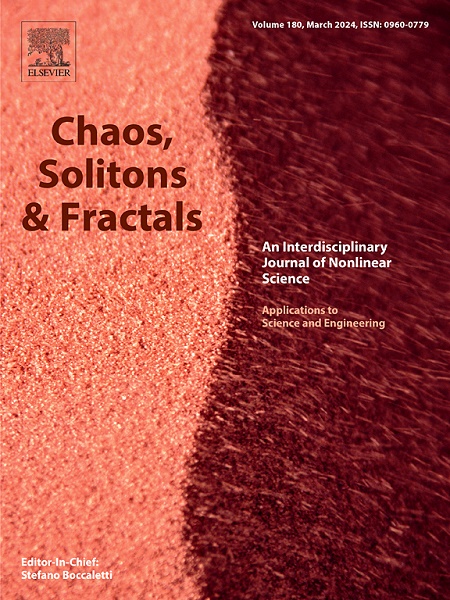能量约束再现的电阻耦合下科尔皮茨电路的同步动力学
IF 5.3
1区 数学
Q1 MATHEMATICS, INTERDISCIPLINARY APPLICATIONS
引用次数: 0
摘要
同步是一种集体行为,已经在各种有趣的系统中被发现,比如电子设备和神经元激发电路。非线性电路的动力学机制一直是一个引人关注的课题。本文主要研究Colpitts电路的同步动力学。通过理论分析和数值模拟相结合,将电路视为双膜神经元,可以在不同参数设置下表现出复杂的动态特性。基于李雅普诺夫稳定性理论,证明了驱动响应电路在单向电阻和电感耦合下可以实现全局指数同步。利用亥姆霍兹定理推导出了科尔皮茨电路的哈密顿能量函数。具有能量约束的驱动响应电路也能显示同步。最后,对Colpitts电路网络的同步机制进行了研究。研究发现,电阻耦合或能量约束能够促进网络的同步。与以往对具有电阻或电感耦合的Colpitts电路的研究相比,我们的工作独特地集成了能量约束,揭示了双重同步机制。这种方法不仅解决了理解非线性电路中能量驱动同步的空白,而且为节能电子系统设计提供了一种新的框架。该研究不仅丰富了非线性动力学同步的理论基础,而且为相应电子系统的设计和优化提供了重要的指导。本文章由计算机程序翻译,如有差异,请以英文原文为准。
Synchronization dynamics of Colpitts circuits under resistive couplings reproduced by energy constraint
Synchronizations, one of collective behaviors, has been found in various interesting systems such as electronic devices and neuron-inspired circuits. The dynamical mechanism of nonlinear circuits remains to be an attracting topic. This paper focuses on the synchronization dynamics of Colpitts circuits. The circuit regarded as a bi-membrane neuron can exhibit complex dynamical characteristics under different parameter settings by combining theoretical analysis and numerical simulation. Based on the Lyapunov stability theory, it is proved that the drive-response circuit can achieve global exponential synchronization under unidirectional resistive and inductive couplings. A Hamilton energy function of the Colpitts circuit is deduced by employing the Helmholtz's theorem. The drive-response circuit with energy constraint is also able to show the synchronization. Finally, the synchronization mechanism of Colpitts circuit networks is investigated. It is found that the resistive coupling or the energy constraint has ability to promote the synchronization of the network. Compared to previous studies on Colpitts circuits with resistive or inductive couplings, our work uniquely integrates energy constraint to reveal a dual synchronization mechanism. This approach not only addresses the gap in understanding energy-driven synchronization in nonlinear circuits but also provides a novel framework for energy-efficient electronic system design. This study not only enriches the theoretical basis in the synchronization of nonlinear dynamics, but also provides important guidance for the design and optimization of corresponding electronic systems.
求助全文
通过发布文献求助,成功后即可免费获取论文全文。
去求助
来源期刊

Chaos Solitons & Fractals
物理-数学跨学科应用
CiteScore
13.20
自引率
10.30%
发文量
1087
审稿时长
9 months
期刊介绍:
Chaos, Solitons & Fractals strives to establish itself as a premier journal in the interdisciplinary realm of Nonlinear Science, Non-equilibrium, and Complex Phenomena. It welcomes submissions covering a broad spectrum of topics within this field, including dynamics, non-equilibrium processes in physics, chemistry, and geophysics, complex matter and networks, mathematical models, computational biology, applications to quantum and mesoscopic phenomena, fluctuations and random processes, self-organization, and social phenomena.
 求助内容:
求助内容: 应助结果提醒方式:
应助结果提醒方式:


